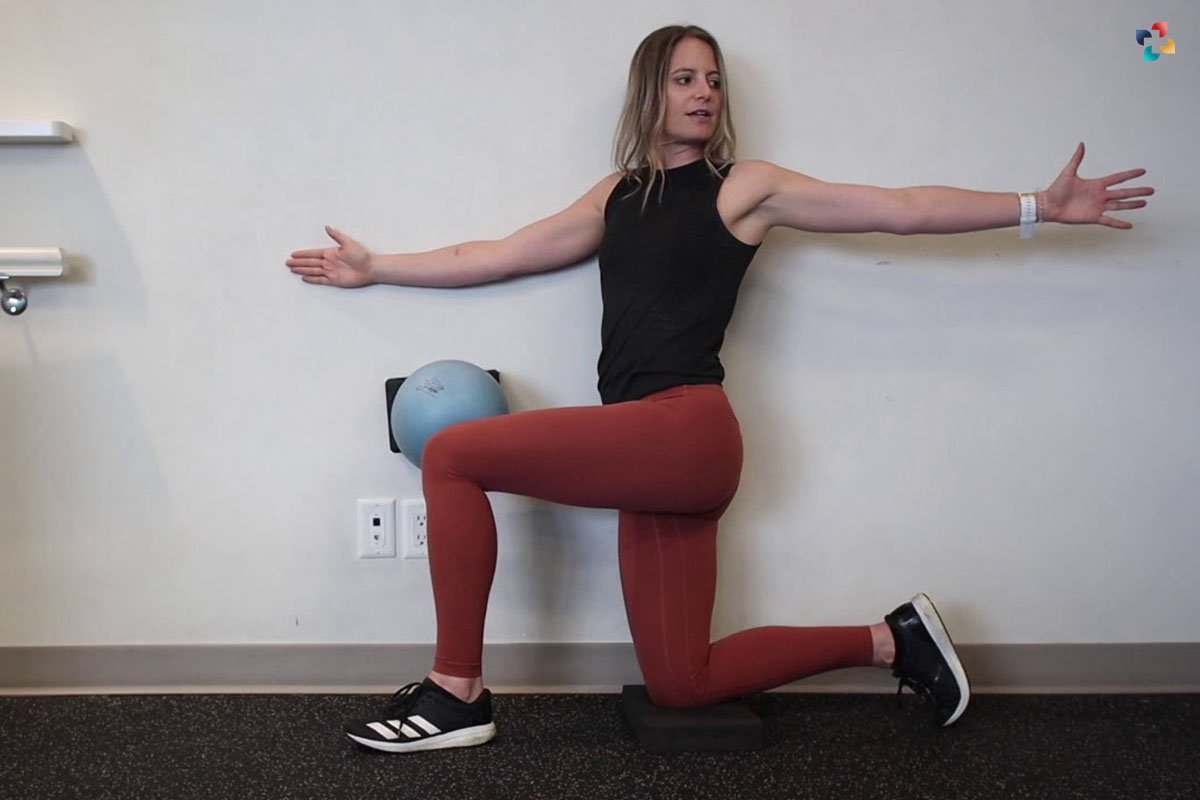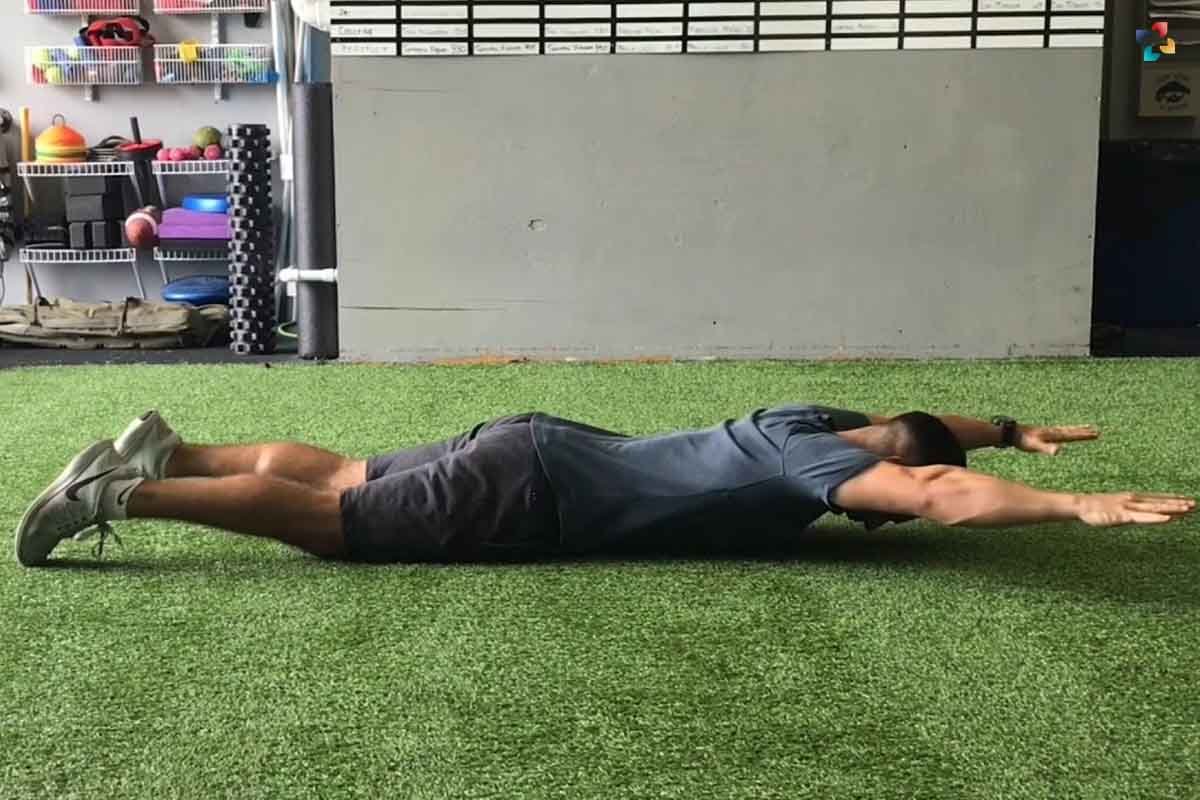With thoracic mobility exercises, you can strengthen your shoulders and increase your range of motion. Shoulders are very mobile joints. As a consequence, if you have weakness or inflexibility in this body area, they may frequently become unpleasant and bothersome.
This may lead to impairment and difficulties doing everyday duties as you become older. As a result, you should do all possible to maintain your shoulders healthy as you become older.
Here are 10 Thoracic Mobility Exercises to Address Shoulder Pain;
1. Side-Lying T Rotations
This exercise is excellent for developing thoracic mobility exercises and spine and shoulder mobility.
By doing this motion regularly, you will gradually improve your capacity to reach behind you and treat numerous reasons for tension and pain in the front of your shoulders.
How to Do It:
- Begin by resting on your right side, in fetal posture.
- Next, twist your body to the left by reaching your left hand toward the ceiling.
- Try to rotate far enough to lay your left hand on the ground while keeping your legs in the initial position.
- Your arms should be in a “T” shape at this stage.
Hold this posture for two minutes before switching sides. This move should be done once every day.
2. Double Kneeling Thoracic Openers
This stretch, like the preceding thoracic mobility exercises, is excellent for opening up the chest, shoulders, and mid-back.

How to Do It:
- Begin by placing both knees and both hands on the ground.
- Place your left hand on top of your head, elbow bent.
- Rotate to the left while keeping your right hand on the ground and aiming to point your left elbow toward the ceiling.
- When you’ve reached the limit of your range of motion, rotate back to the right until your elbow is again directed toward the ground.
Once a day, repeat 10 times on each side.
3. Foam Roller Thoracic Spine Release
This “workout” is really enjoyable for the majority of individuals. To be honest, all you have to do to do this stretch is lie back and relax!
How to Do It:
- Sit in front of a foam roller that has been placed on the ground.
- Place your hands behind your head and lean back, allowing the foam roller to rest on your upper back.
- Lean back as far as you can comfortably over the foam roller.
- You may add a massage component by carefully gliding your body up and down on the foam roller with your legs.
Hold this posture for at least 2 minutes and repeat this technique every day.
4. Prone Y’s
The next thoracic mobility exercises in this series are excellent for rotator cuff and trap strength. These motions greatly enhance shoulder stability.
How to Do It:
- Lie on your stomach, arms outstretched in front of you, above your head.
- Lift your arms toward the sky, forming a “Y” shape with your body.
- Hold for one second, then slowly lower your arms to the ground.
Repeat this exercise for 10 repetitions, 3 sets, and 2-3 times each week.
5. Prone T’s
The prone T, like the last exercise, targets the rotator cuff as well as the mid-traps and rhomboids.
How to Do It:
- Begin by laying on your stomach, arms extended out to the sides.
- Raise your hands to the sky, maintaining your elbows straight.
- Your body should be in the form of a “T” at this stage.
- Hold for a second before lowering your arms to the ground.
Repeat this exercise for 10 repetitions, 3 sets, and 2-3 times each week.
6. Prone I’s
This is another “letter” practice. Each of these maneuvers places unique stress on specific areas of the upper back and shoulders, resulting in strength and stability that are difficult to accomplish with conventional movements.
How to Do It:
- Lie down on your stomach with your arms straight up over your head.
- This is a posture comparable to the “Y” exercise. Your arms, on the other hand, will be somewhat more closely spaced, with your biceps near your ears.
- Raise your arms off the ground and toward the ceiling.
- Hold for one second before returning your arms to the ground.
- Rep 10 reps for 3 sets, 2-3 times each week.
7. The Prone W’s
This is the last exercise in our alphabet series, and it’s a doozy! W’s are very difficult because they need a lot of movement in the shoulders and upper back.

How to Carry Out
- Lie on your stomach, hands at your ears, and elbows bent.
- Lift your hands, elbows, and arms off the ground and up toward the ceiling.
- Hold for one second before returning your arms to the ground.
Repeat for ten repetitions every set, three sets per session, and two to three sessions per week.
8. Standing Horizontal Abduction with Band
The standing horizontal abduction exercise is similar to the prone T exercise. However, since it does not require the exerciser to go down on the floor, this variation of the action is more pleasant for most individuals.
How to Do It:
- Begin by standing with your feet about hip-width apart.
- Then, with both hands, hold a band.
- Raise the band to shoulder height and pull it apart, pressing your shoulder blades together.
Perform 10-12 repetitions each set, three sets per session, and two to three sessions per week.
9. Snow Angels on the Wall
Last but not least, there is the snow angel activity. The snow angels on the wall are maybe the most challenging of the exercises described in this essay.
This technique requires remarkable thoracic mobility exercises and stability in the shoulder area, and few individuals can master it on their first attempt!
How to Do It:
- Begin by standing with your back against the wall, with your heels, buttocks, shoulders, low back, and head in contact with it.
- Next, form a “W” with your elbows, forearms, and hands on the wall.
- Maintain this posture by sliding your arms up the wall, making sure that no part of your body loses touch with the surface.
- Then, to finish the exercise, return your arms to the beginning position.
Perform ten to twelve repetitions each set, three sets per session, and two to three sessions per week.
10. Thread Needle Exercise
Thread-the-needle stretching stretches the sides and backs of your shoulders as well as your mid back. It’s an excellent shoulder stretch for relieving pain and stress. More mid-back thoracic mobility exercises may be found here.

How to Do It:
- Position yourself on all fours, hands on a yoga mat, knees hip-width apart. Adjust your hands to be shoulder-width apart and precisely under your shoulders.
- Your knees should be just under your hips. Raise your right arm slowly toward the ceiling, tilting your neck up to follow the hand.
- Bring your arm down and reach behind your rib cage. Continue until your right shoulder contacts the mat and your right-hand goes through your body’s left side. Follow the right arm with your head and place it on the mat where your right shoulder is.
- The right side of your face should be down. Stretch your neck, shoulders, rhomboid, and back. Take a few deep breaths. Return to the beginning and exchange sides.
BOTTOM LINE
Shoulder thoracic mobility exercises are an often overlooked aspect of wellness. Having strong, mobile shoulders, on the other hand, is one of the strongest indicators of general good health later in life. It’s important to warm up properly before performing thoracic mobility exercises to prevent injuries. Athletes who participate in sports that require rotational movements, like golf or tennis, can benefit greatly from incorporating thoracic mobility exercises into their training regimen.
To Know More About Exercises Click Here: 12 Exercises for a Healthy Back







